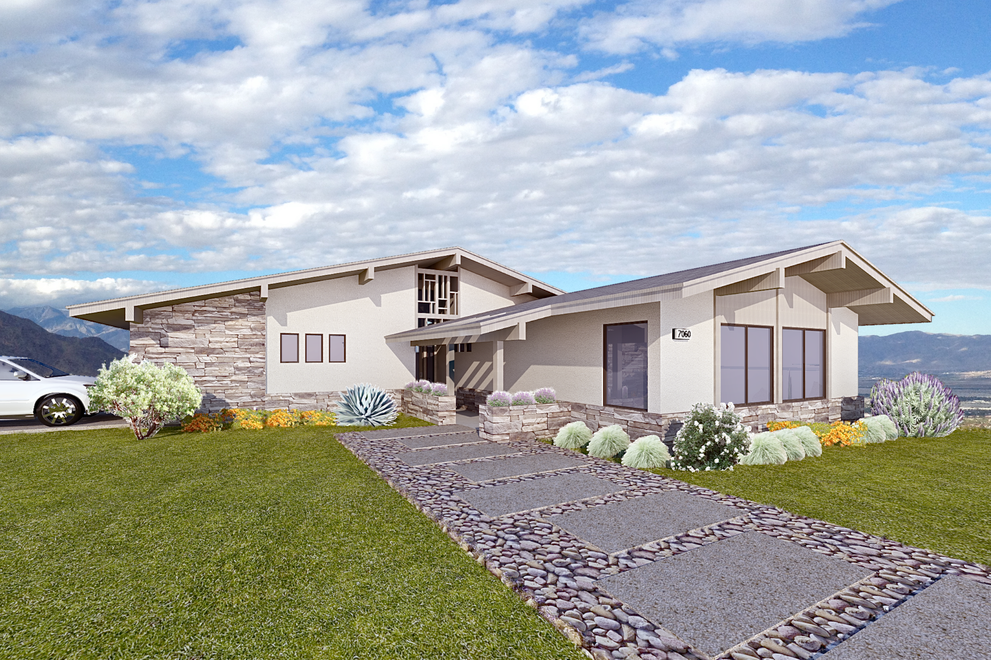Plan 470-6, above.
One fine spring afternoon in 2009, on a routine prospecting run through Sunnyvale, Calif., a rather glamorous young real estate agent named Monique Lombardelli drove her Volkswagen sedan into a better, bygone world. Lombardelli had spent her first several months as a Realtor in the midst of the worst economic downturn since the Great Depression. Nevertheless, based as she was in Silicon Valley, there were still plenty of potential clients in the market for an ersatz Spanish mission or an overblown ranch home that made up in bonus bathrooms and surround-sound theater seating what it lacked in restraint.
In the neighborhood she had stumbled into, she discovered a street rippling like a wave, along which stretched late 1950s tract homes. Their geometry of rectangles and triangles had much more in common with the post-and-beam monuments of midcentury architecture than it did with the gimcrack plaster and stucco of Levittown, or certainly the nouveau-riche glitz erupting through the surrounding Silicon Valley. "You know when you play a sport," Lombardelli says, "and something happens where out of blue, out of nowhere, you hit a home run or you catch a ball, and you say to yourself, Oh my God! It was that kind of euphoria, an instant feeling."
Pulling her Volkswagen to the curb, she approached a gray-haired man, probably in his 60s, out with his little dog. He told her he had been living in the subdivision most of his life, and soon enough he revealed himself as a design fanatic. "You see this," he said, frowning down at the ridge of a foundation that some neighbor in their insolence had slathered with gray. "Mr. Eichler had these painted black, and he wanted us to keep these black, but some people don't do it."
Mr. Eichler was Joseph Eichler, who spent the first half of his professional life in the wholesale dairy and poultry business, during which his artistic ambitions seemed to go not much farther than bespoke suits and a fondness for Fred Astaire. In middle age, Eichler, based in the Bay Area, found a new calling—to bring midcentury modern living to the common man. Eichler Homes, which he founded in 1949, sold 11,000 of these post-and-beam residences, most of them in the vicinity of America's future tech capital. The earliest Eichlers were priced at $9,600 for just over 1,000 square feet, and though the models increased in price and square footage during the company's late 1950s heyday, a vet could still purchase one with $800 down.
Among the architects Eichler hired were Los Angeles–based A. Quincy Jones—who designed media mogul Walter Annenberg's mansion in Rancho Mirage, Calif., and actor Gary Cooper's estate in L.A.'s Holmby Hills—and Robert Anshen, co-founder of San Francisco–based firm Anshen + Allen, which was acquired by Stantec in 2010.
To read more click here.
To see more Eichler plans click here.
One fine spring afternoon in 2009, on a routine prospecting run through Sunnyvale, Calif., a rather glamorous young real estate agent named Monique Lombardelli drove her Volkswagen sedan into a better, bygone world. Lombardelli had spent her first several months as a Realtor in the midst of the worst economic downturn since the Great Depression. Nevertheless, based as she was in Silicon Valley, there were still plenty of potential clients in the market for an ersatz Spanish mission or an overblown ranch home that made up in bonus bathrooms and surround-sound theater seating what it lacked in restraint.
In the neighborhood she had stumbled into, she discovered a street rippling like a wave, along which stretched late 1950s tract homes. Their geometry of rectangles and triangles had much more in common with the post-and-beam monuments of midcentury architecture than it did with the gimcrack plaster and stucco of Levittown, or certainly the nouveau-riche glitz erupting through the surrounding Silicon Valley. "You know when you play a sport," Lombardelli says, "and something happens where out of blue, out of nowhere, you hit a home run or you catch a ball, and you say to yourself, Oh my God! It was that kind of euphoria, an instant feeling."
Pulling her Volkswagen to the curb, she approached a gray-haired man, probably in his 60s, out with his little dog. He told her he had been living in the subdivision most of his life, and soon enough he revealed himself as a design fanatic. "You see this," he said, frowning down at the ridge of a foundation that some neighbor in their insolence had slathered with gray. "Mr. Eichler had these painted black, and he wanted us to keep these black, but some people don't do it."
Mr. Eichler was Joseph Eichler, who spent the first half of his professional life in the wholesale dairy and poultry business, during which his artistic ambitions seemed to go not much farther than bespoke suits and a fondness for Fred Astaire. In middle age, Eichler, based in the Bay Area, found a new calling—to bring midcentury modern living to the common man. Eichler Homes, which he founded in 1949, sold 11,000 of these post-and-beam residences, most of them in the vicinity of America's future tech capital. The earliest Eichlers were priced at $9,600 for just over 1,000 square feet, and though the models increased in price and square footage during the company's late 1950s heyday, a vet could still purchase one with $800 down.
Among the architects Eichler hired were Los Angeles–based A. Quincy Jones—who designed media mogul Walter Annenberg's mansion in Rancho Mirage, Calif., and actor Gary Cooper's estate in L.A.'s Holmby Hills—and Robert Anshen, co-founder of San Francisco–based firm Anshen + Allen, which was acquired by Stantec in 2010.
To read more click here.
To see more Eichler plans click here.






